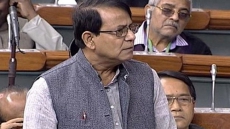Delhi's air quality has dipped to dangerous levels, but no advisories have as yet been issued by the government. On Tuesday evening, the Air Quality Index (AQI) in the capital was at a "very poor" level, touching the 356 mark.
The Central Pollution Control Board (CPCB) defines an AQI between levels 0-50 as "good" quality of air, 51-100 as "satisfactory", 301-400 means "very poor" and 401-500 is "severe".
The CPCB says PM 2.5 and PM 10 (particulate matter suspended in air with diameters 2.5 and 10 micrometers) are the "prominent" pollutants for Delhi's air.
As the world leaders gathered in Paris for a crucial climate change summit, urging nations to act against climate change, the woes of Delhiites fighting smog are likely to continue for the coming week.
"The easterly winds coming towards the city can carry huge moisture. This, along with the pollutants in the air, contribute to smog," India Meteorological Department (IMD) director B.P. Yadav told IANS.
Traces of rain was reported in some parts of the city on Tuesday and the Met department forecasts more foggy days Saturday onwards.
Even prior to Diwali, environmentalists expected the air quality to dip to "alarming" levels, and attributed it to crop burning which took place in the northern belt of the country, and carbon emissions from outdated trucks and vehicles.
"During winters, the cool winds trap pollutants in the air close to the earth. It is an issue Delhi has been experiencing. It requires preparedness and progressive action to fight these pollutants," Anumita Roychowdhury, executive director for research and advocacy at the Centre for Science and Environment (CSE), told IANS.
Roychowdhury said India "does not have very good forecasting systems", to precisely predict how bad the air could get in the coming days, but said over the previous years' experience, levels could hit some lows.
Air of a "very poor" quality can cause "respiratory illness on prolonged exposure", the CPCB says.
According to the Delhi Pollution Control Committee (DPCC), PM 2.5, which can cause harm to humans, has been found at 189 units, as against the prescribed normal of 60 units -- three times more than normal.
According to the World Health Organization (WHO), this was 18 times the prescribed normal, as the WHO suggests PM 2.5 levels to be normal at 10 units.
The PM 10 levels were found at a whopping 709 units, as against the normal level of 100 units -- over seven times the normal level.
This data was recorded at the Anand Vihar air quality monitoring station at 4.50 p.m on Tuesday.
"Delhi air is becoming horrible day by day. Not only does it choke, but my skin is affected so much and I have developed rashes now. I feel the time has come to use air purifier masks every day," Sarbani Sharma, a research scholar, told IANS.
The national capital's AQI touched the 408 mark on Monday, with smog taking over the city's air, causing low visibility.
Delhi, which recently took over Beijing's spot for being the place with the world's filthiest air, has had no instructions from the government despite these high levels of air pollutants. Whereas, if the AQI touches a level of 300 in Beijing, the Chinese government issues an advisory to citizens to stay indoors.
"Beijing has an emergency contingency plan, on what to do when they have a severe smog issue. It is something that India lacks, and hence the need for us to work harder towards setting up systems in place," Roychowdhury added.


